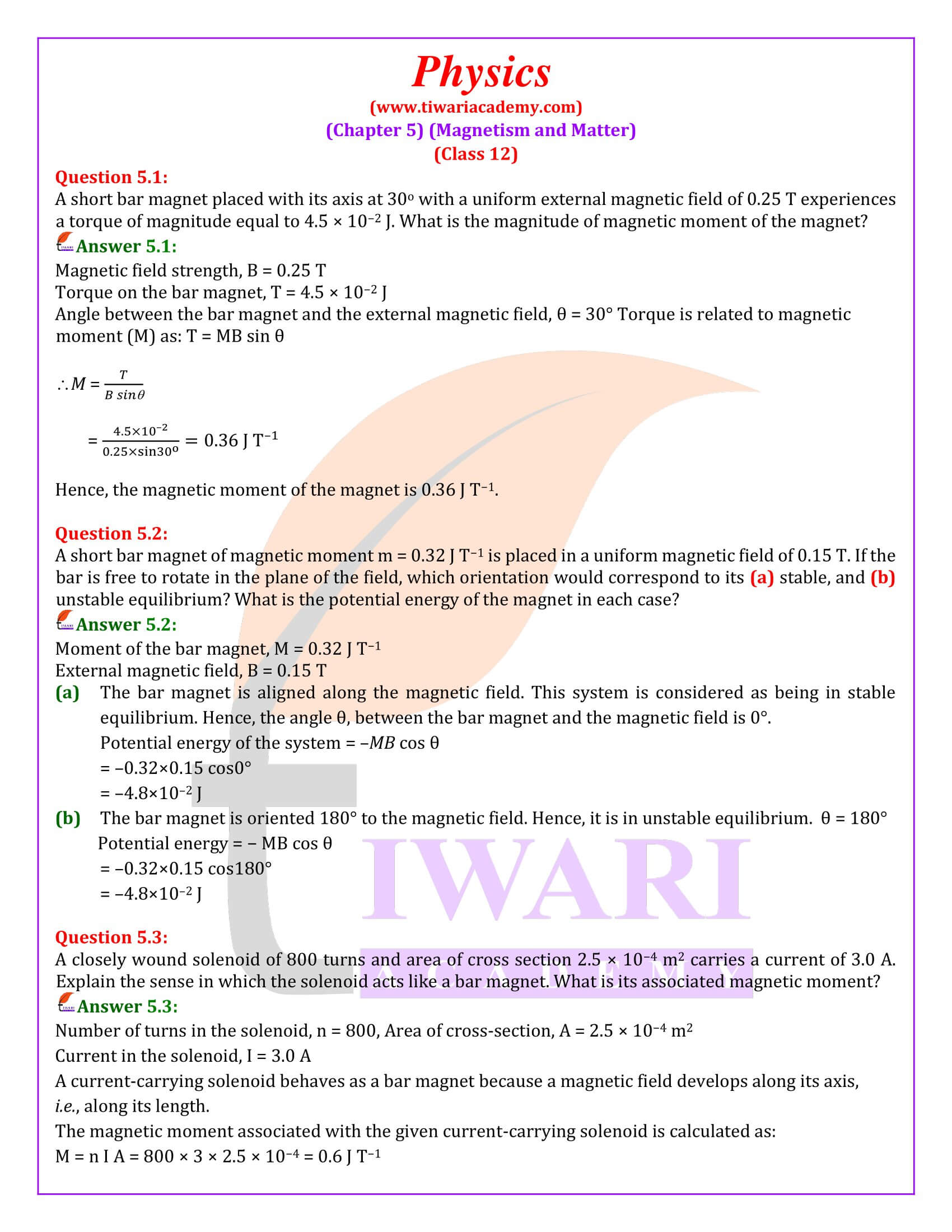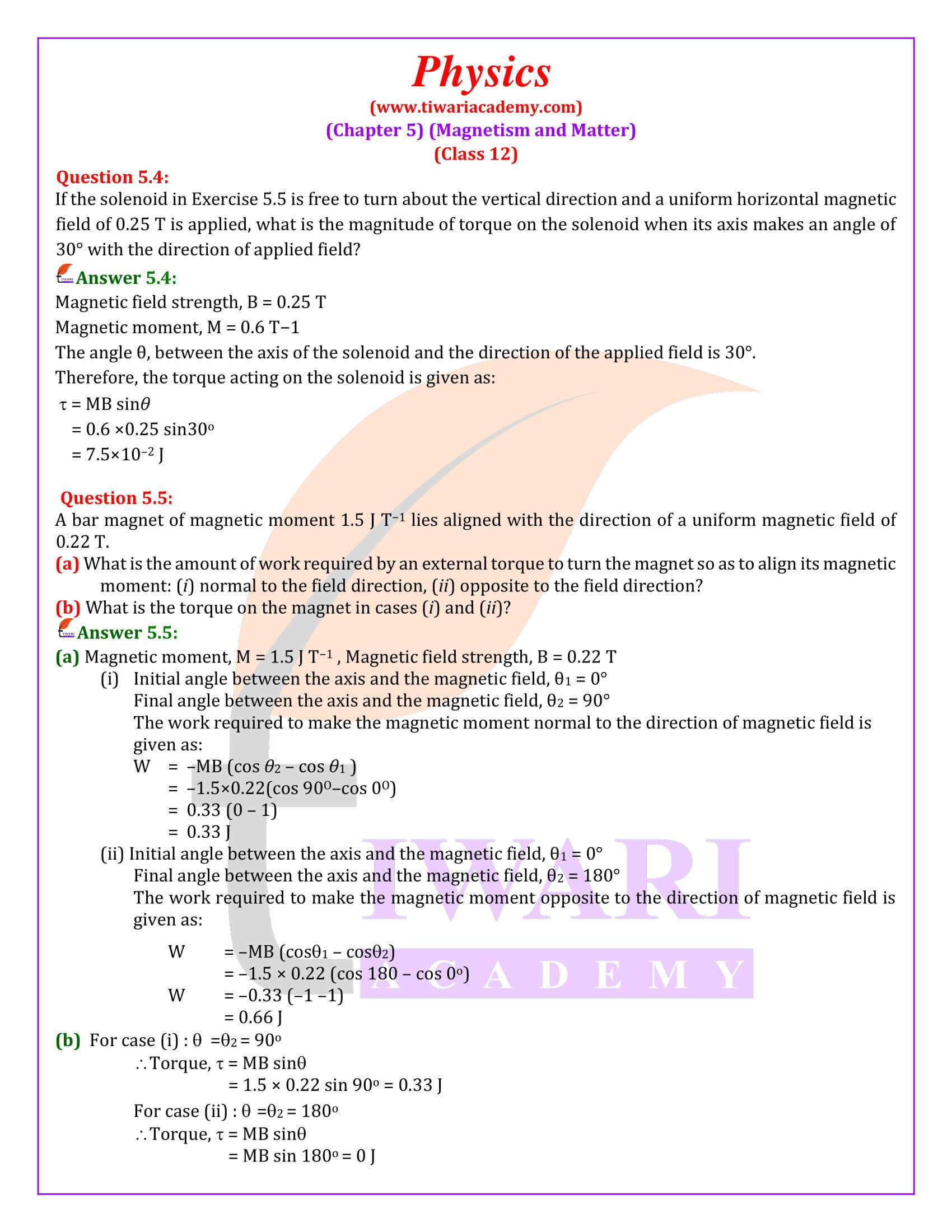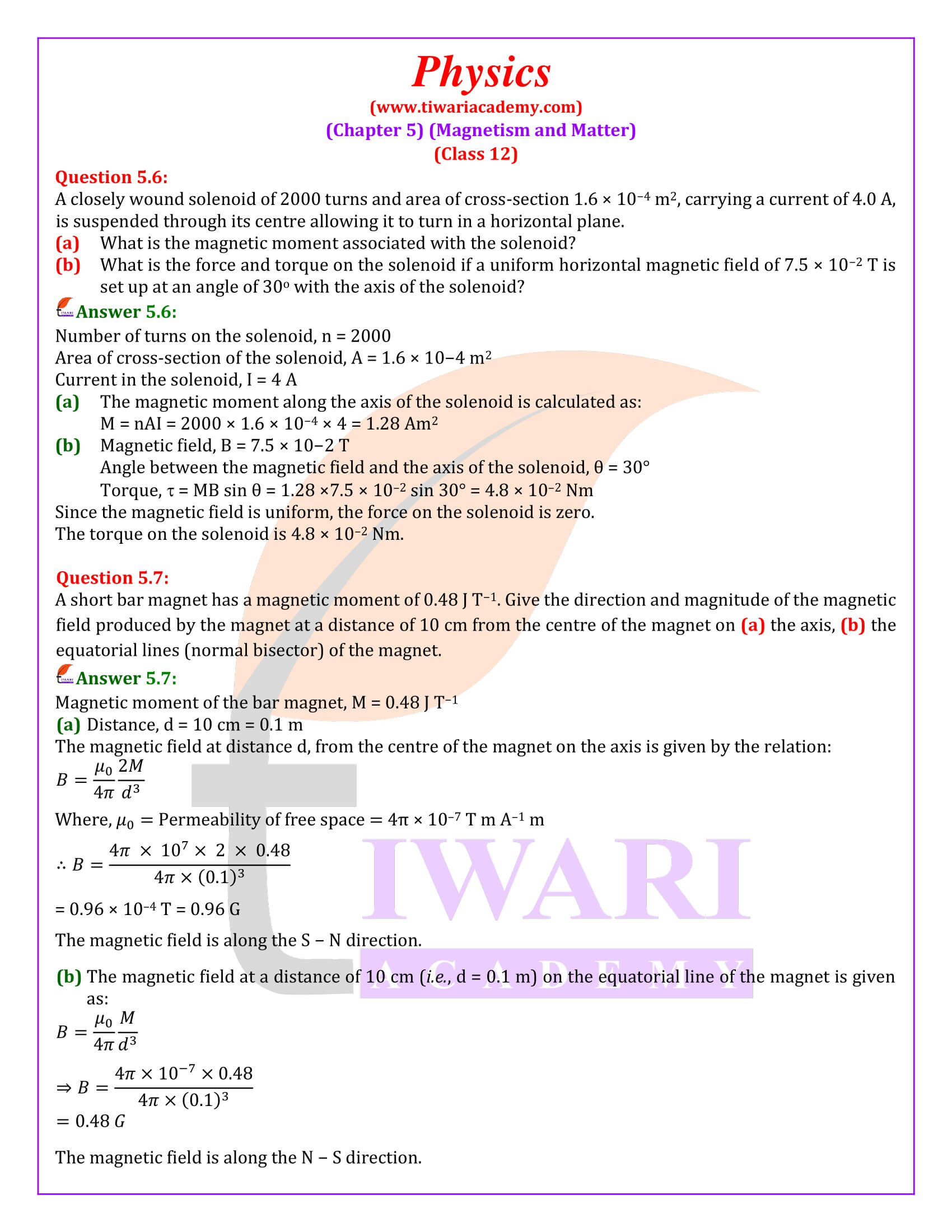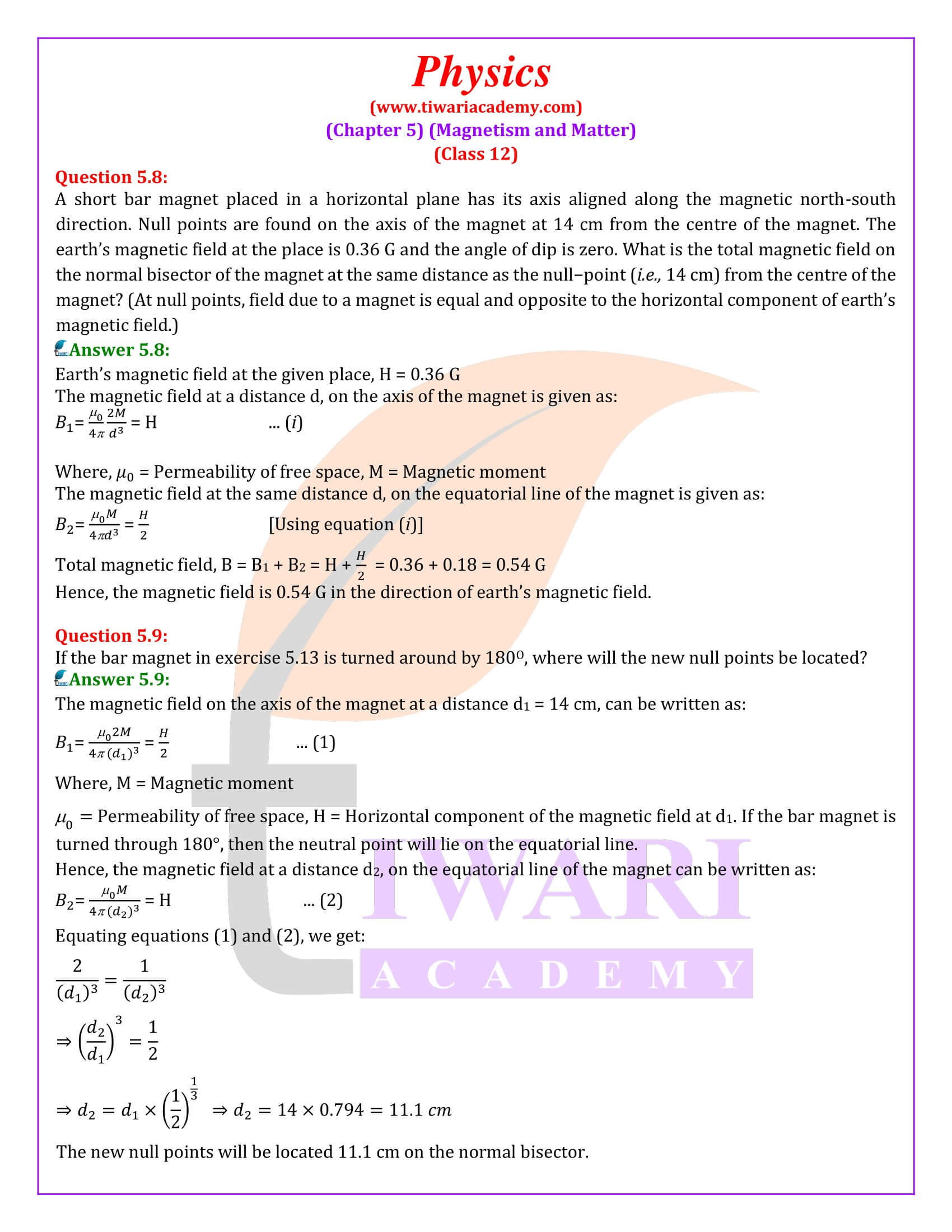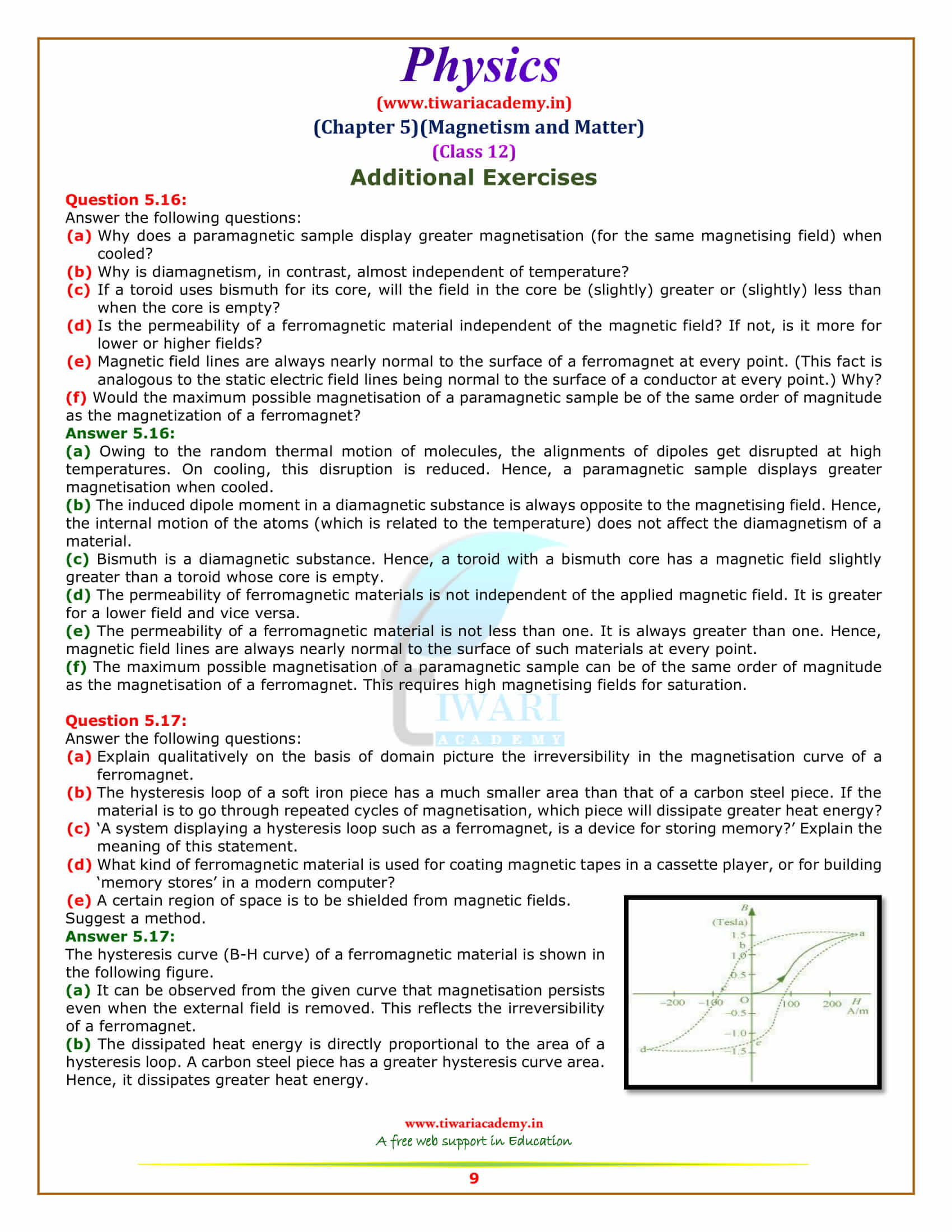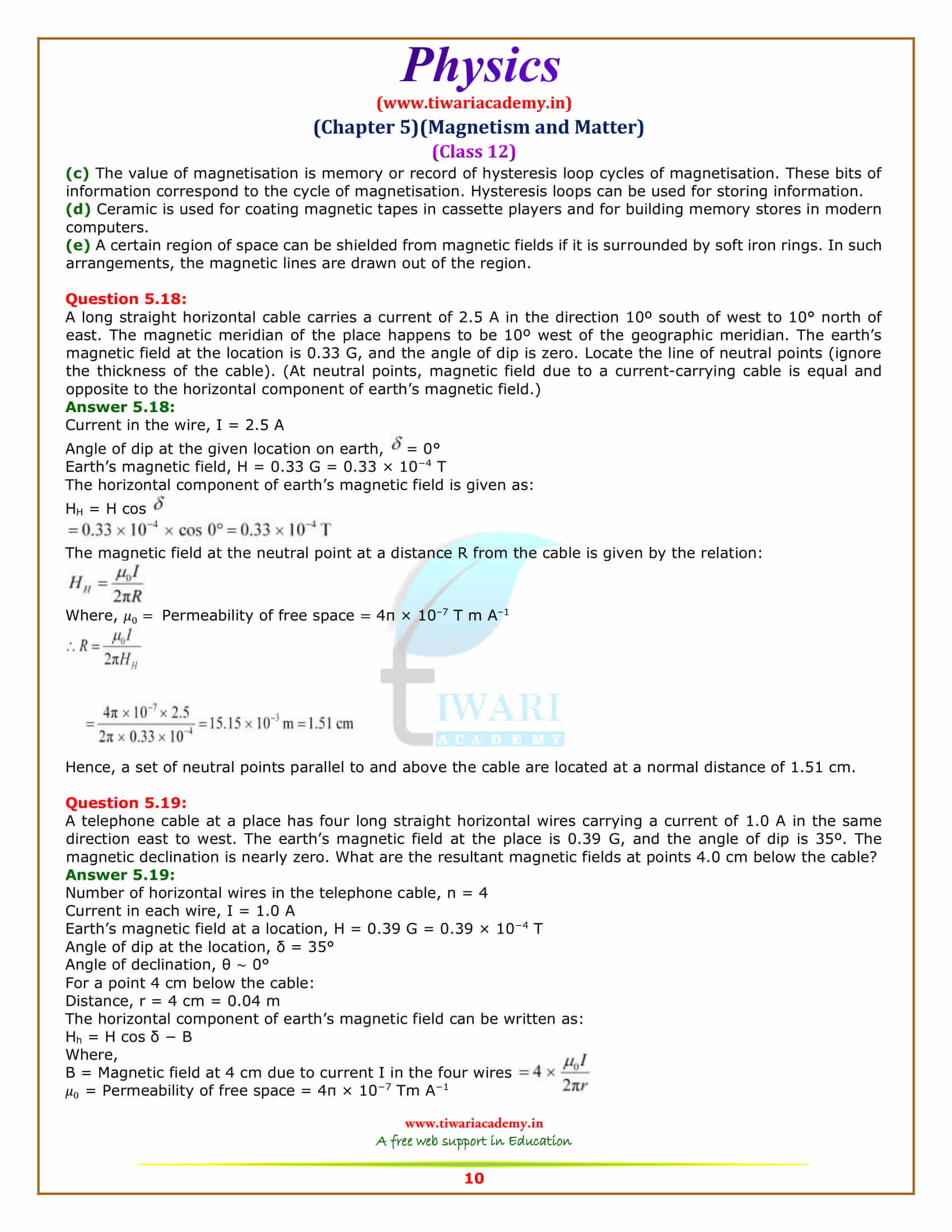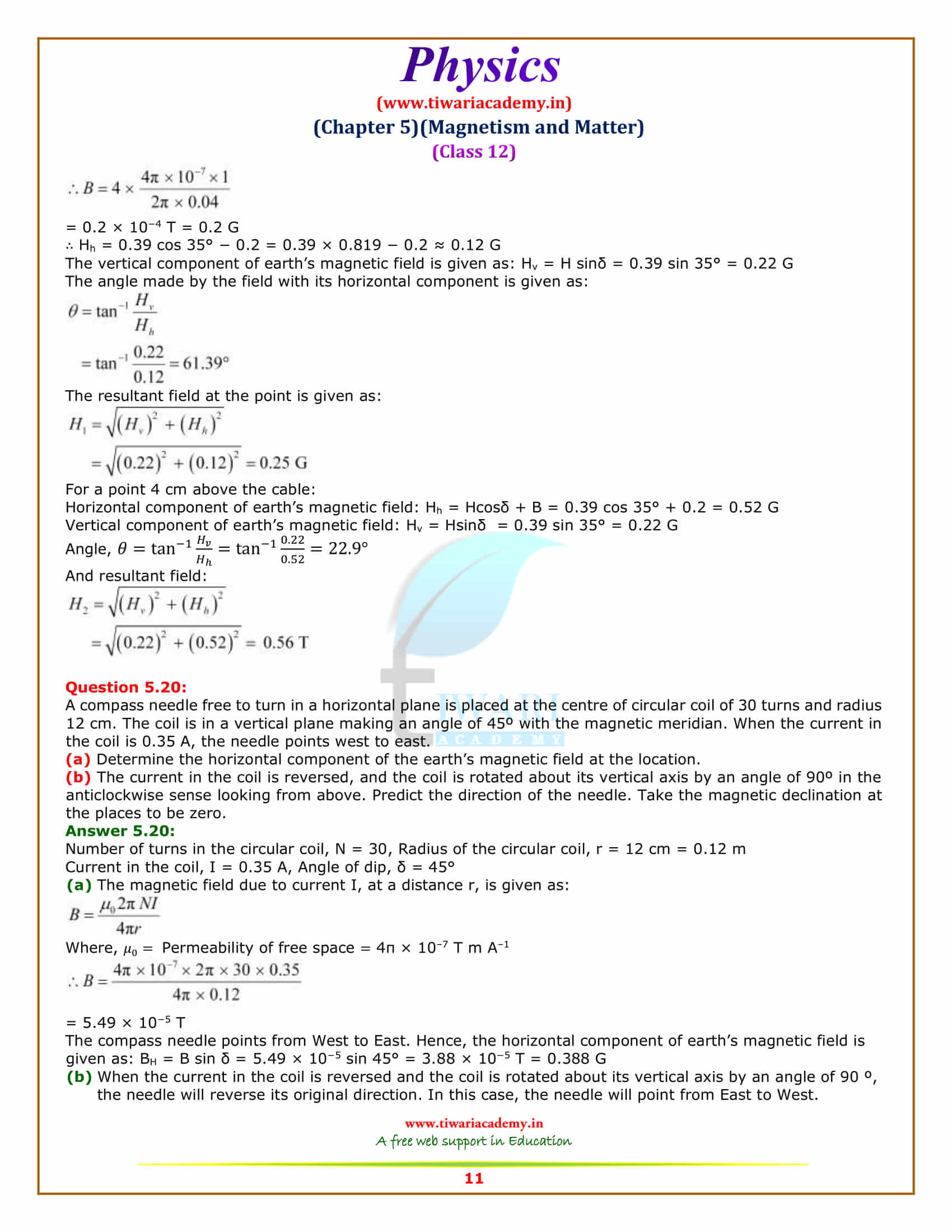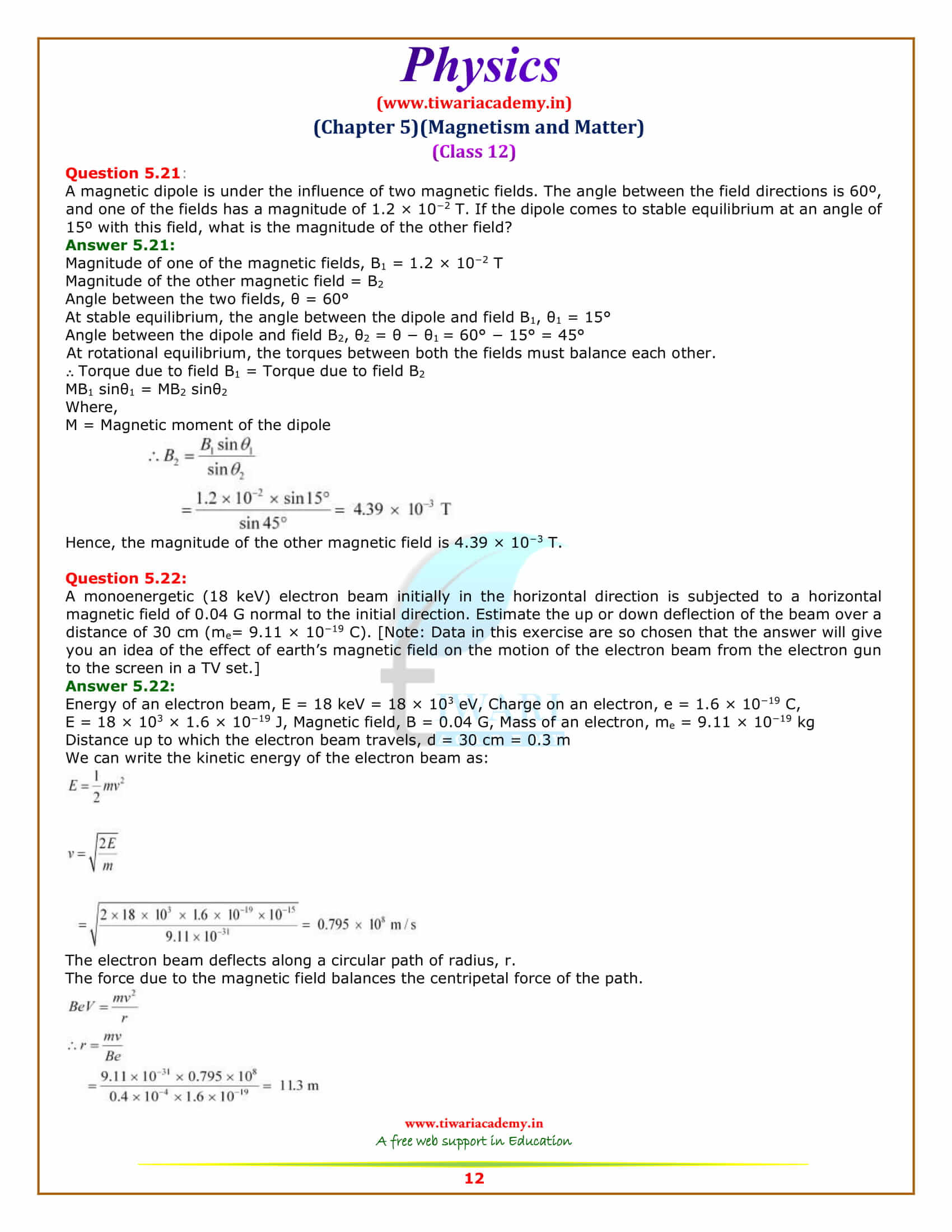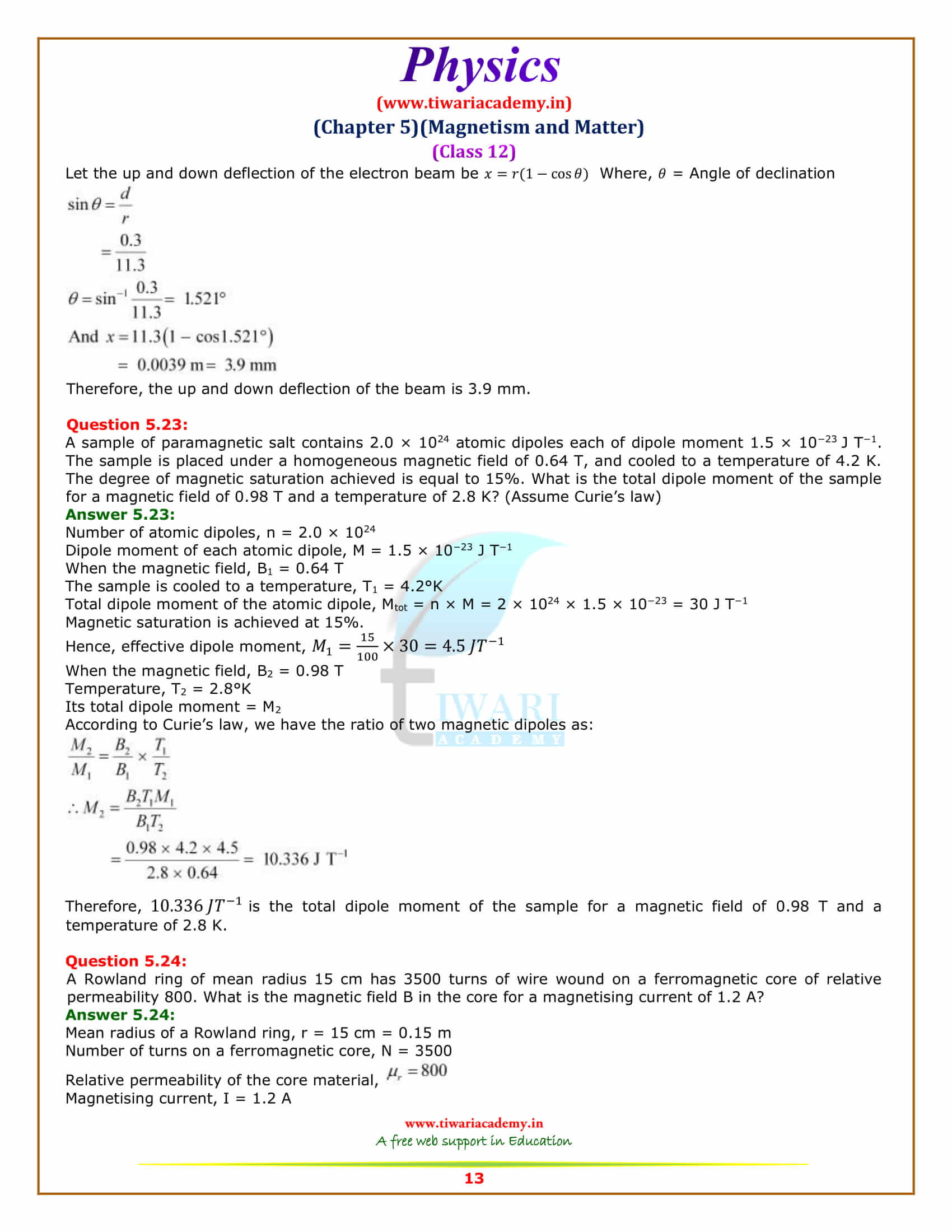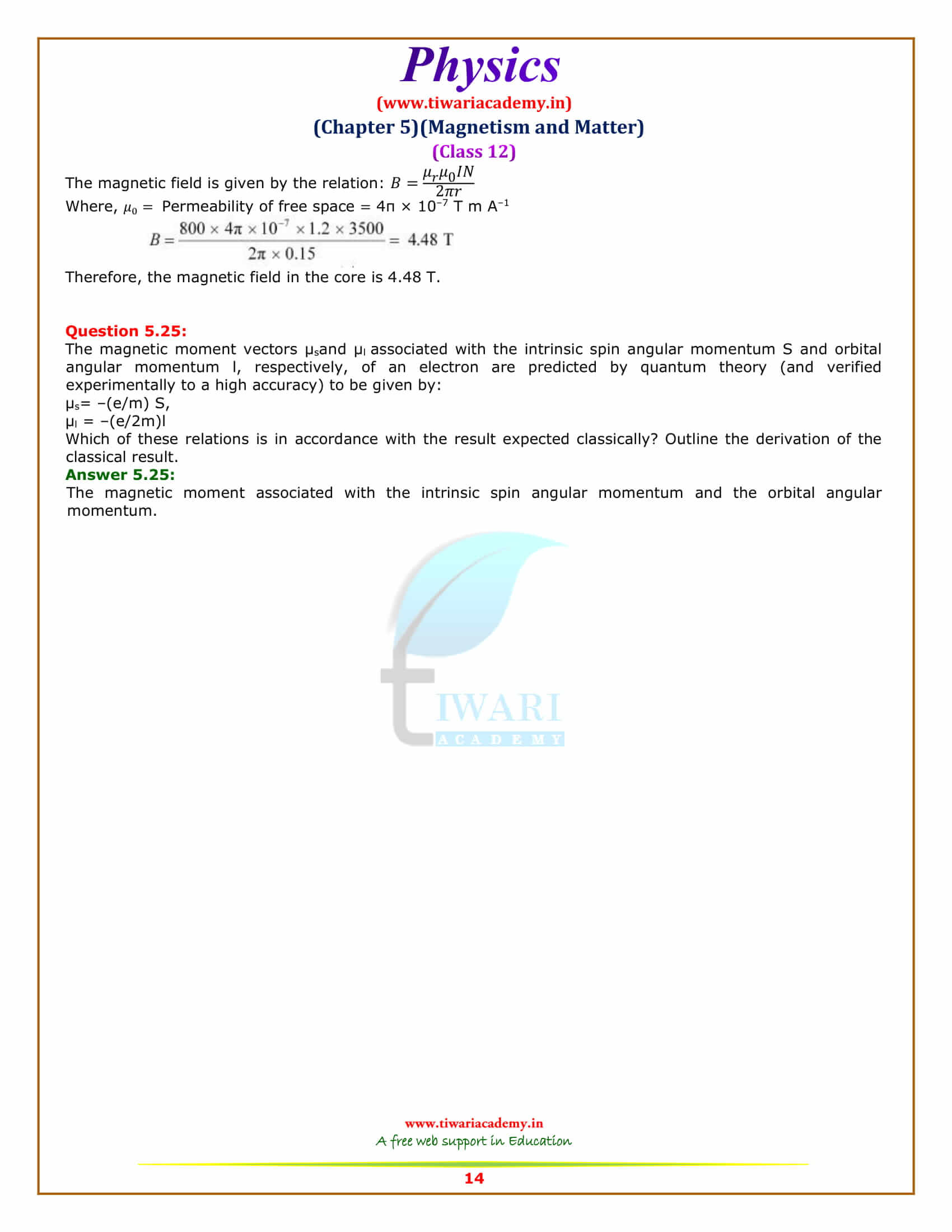NCERT Solutions for Class 12 Physics Chapter 5 Magnetism and Matter Exercises and Additional Exercises in Hindi and English Medium PDF updated for new session 2025-26. As per the new textbooks issued for academic year 2025-26, additional exercises are not the part of syllabus.
Viva Voice for Class 12 Physics Practical
How to Prepare for Class 12 Physics Exams
Tips and Tricks for Class 12 CBSE Board 2025
NCERT Solutions for Class 12 Physics Chapter 5
Chapter 5 Magnetism and Matter Solutions
- Class 12 Physics Chapter 5 Exercises Solutions
- 12th Physics Chapter 5 Additional Exercises (Not in Syllabus)
- Class 12 Physics Chapter 5 Solutions in Hindi
- Class 12 Physics NCERT Book Chapter 5
- Class 12 Physics Revision Book Chapter 5
- Revision Book Answers
- Class 12 Physics Chapter 5 Revision Notes 1
- Class 12 Physics Chapter 5 Revision Notes 2
- Visit to 12th Physics Main Page
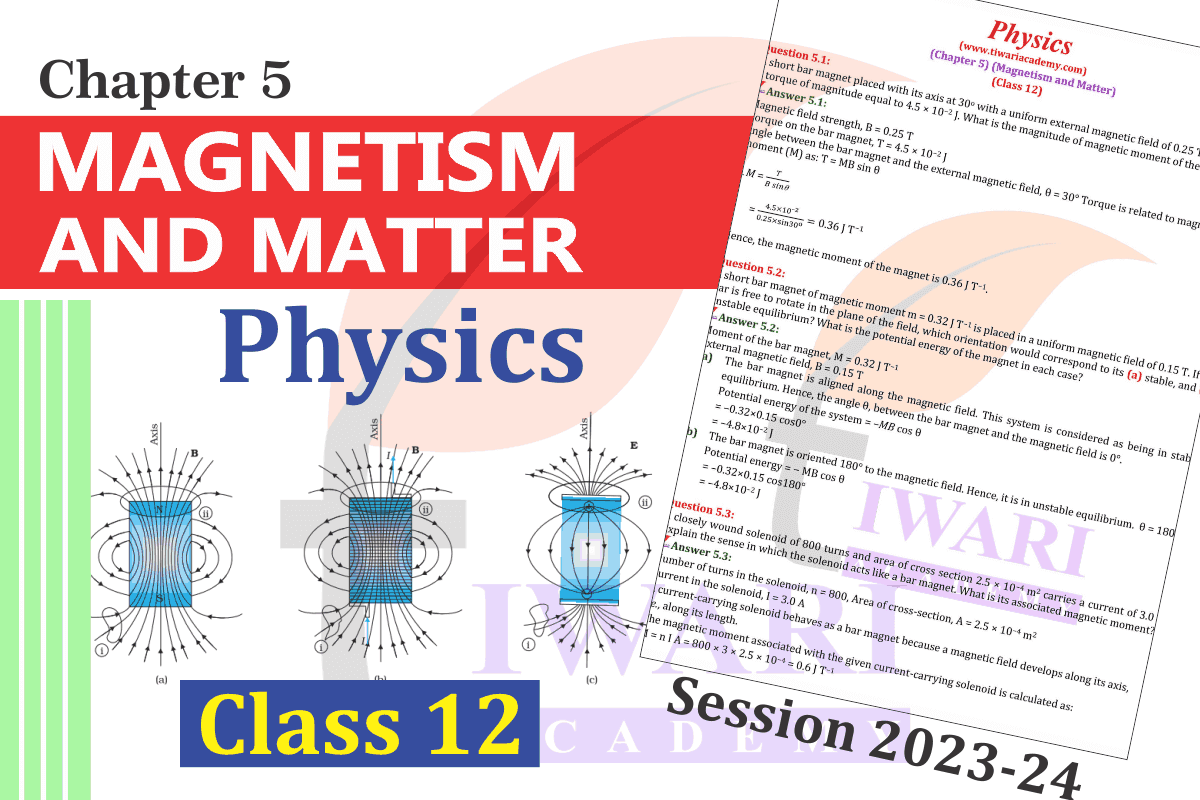
UP Board Solutions and CBSE Solutions as well as NCERT Sols Apps are as per latest CBSE Syllabus for 2025-26.
| Class: 12 | Physics |
| Chapter 5: | Magnetism and Matter |
| Content: | Exercises and Practice Questios |
| Mode of Content: | Text, PDF, Images and Videos |
| Session: | Academic Year 2025-26 |
| Medium: | Hindi and English |
Class 12 Physics Chapter 5 Solutions in English
NCERT Solutions for Class 12 Physics Chapter 5 in PDF form to free download is given below for new academic session 2025-26. Ask your questions related to NIOS Board or CBSE Board via Discussion Forum and answer the questions already asked by the other users. Download NCERT Books based on latest CBSE Syllabus 2025-26.
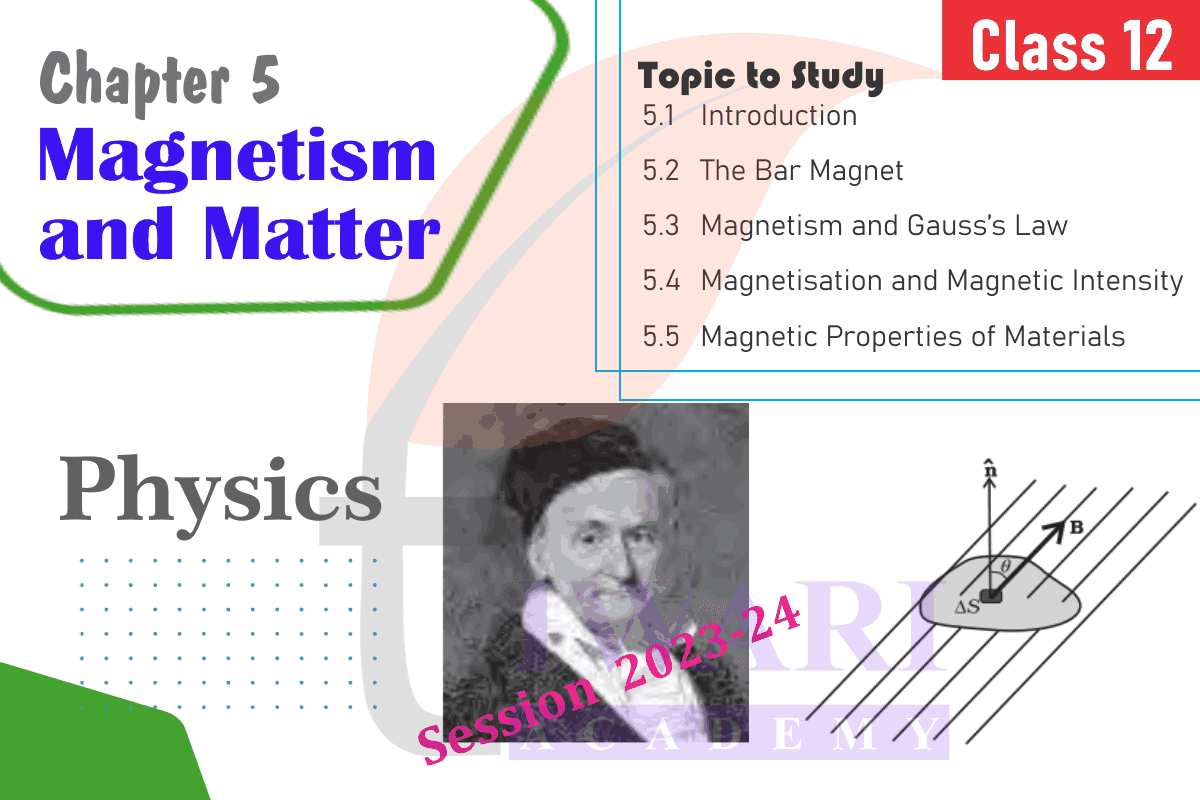
Important Questions for practice
1. A steady current I flows along an infinitely long straight wire with circular cross-section of radius R. What will be the magnetic field outside and inside the wire at a point r distance far from the axis of wire?
2. A galvanometer coil has a resistance G. 1% of the total current goes through the coil and rest through the shunt. What is the resistance of the shunt?
3. A particle of mass m and charge q moves at right angles to a uniform magnetic field. Plot a graph showing the variation of the radius of the circular path described by it with the increase in its kinetic energy, where, other factors remain constant.
4. A coil of N turns and radius R carries a current I. It is unwound and rewound to make another coil of radius R/2, current remaining the same. Calculate the ratio of the magnetic moment of the new coil and original coil.
5. Define the term magnetic dipole moment of a current loop. Write the expression for the magnetic moment when an electron revolves at a speed ‘v’, around an orbit of radius ‘r’ in hydrogen atom.
Questions from Board Papers
1. The divisions marked on the scale of an a.c. ammeter are not equally spaced. Why?
2. How does an inductor behave in a DC circuit after the current reaches to steady state? Justify.
3. Derive the expression for force between two infinitely long parallel straight wires carrying current in the same direction. Hence define ‘ampere’ on the basis of above derivation.
4. Obtain an expression for the magnetic moment of an electron moving with a speed ‘v’ in a circular orbit of radius ‘r’. How does this magnetic moment change when:
i). the frequency of revolution is doubled?
ii). the orbital radius is halved?
5. A long wire is first bent into a circular coil of one turn and then into a circular coil of smaller radius having n turns. If the same current passes in both the cases, find the ratio of the magnetic fields produced at the centres in the two cases.
Important Questions on 12th Physics Chapter 5
A vector needs three quantities for its specification. Name the three independent quantities conventionally used to specify the earth’s magnetic field.
The three independent quantities conventionally used for specifying earth’s magnetic field are: (i) Magnetic declination, (ii) Angle of dip, and (iii) Horizontal component of earth’s magnetic field
The angle of dip at a location in southern India is about 18º. Would you expect a greater or smaller dip angle in Britain?
The angle of dip at a point depends on how far the point is located with respect to the North Pole or the South Pole. The angle of dip would be greater in Britain (it is about 70°) than in southern India because the location of Britain on the globe is closer to the magnetic North Pole.
If you made a map of magnetic field lines at Melbourne in Australia, would the lines seem to go into the ground or come out of the ground?
It is hypothetically considered that a huge bar magnet is dipped inside earth with its north pole near the geographic South Pole and its south pole near the geographic North Pole. Magnetic field lines emanate from a magnetic north pole and terminate at a magnetic south pole. Hence, in a map depicting earth’s magnetic field lines, the field lines at Melbourne, Australia would seem to come out of the ground.
In which direction would a compass free to move in the vertical plane point to, if located right on the geomagnetic north or South Pole?
If a compass is located on the geomagnetic North Pole or South Pole, then the compass will be free to move in the horizontal plane while earth’s field is exactly vertical to the magnetic poles. In such a case, the compass can point in any direction.
Geologists claim that besides the main magnetic N-S poles, there are several local poles on the earth’s surface oriented in different directions. How is such a thing possible at all?
Yes, there are several local poles on earth’s surface oriented in different directions. A magnetised mineral deposit is an example of a local N-S pole.
The earth’s magnetic field varies from point to point in space. Does it also change with time? If so, on what time scale does it change appreciably?
Earth’s magnetic field changes with time. It takes a few hundred years to change by an appreciable amount. The variation in earth’s magnetic field with the time cannot be neglected.
The earth’s core is known to contain iron. Yet geologists do not regard this as a source of the earth’s magnetism. Why?
Earth’s core contains molten iron. This form of iron is not ferromagnetic. Hence, this is not considered as a source of earth’s magnetism.
The charged currents in the outer conducting regions of the earth’s core are thought to be responsible for earth’s magnetism. What might be the ‘battery’ (i.e., the source of energy) to sustain these currents?
The radioactivity in earth’s interior is the source of energy that sustains the currents in the outer conducting regions of earth’s core. These charged currents are considered to be responsible for earth’s magnetism.
The earth may have even reversed the direction of its field several times during its history of 4 to 5 billion years. How can geologists know about the earth’s field in such distant past?
Earth reversed the direction of its field several times during its history of 4 to 5 billion years. These magnetic fields got weakly recorded in rocks during their solidification. One can get clues about the geomagnetic history from the analysis of this rock magnetism.
The earth’s field departs from its dipole shape substantially at large distances (greater than about 30,000 km). What agencies may be responsible for this distortion?
Earth’s field departs from its dipole shape substantially at large distances (greater than about 30,000 km) because of the presence of the ionosphere. In this region, earth’s field gets modified because of the field of single ions. While in motion, these ions produce the magnetic field associated with them.
Interstellar space has an extremely weak magnetic field of the order of 10⁻¹² T. Can such a weak field be of any significant consequence? Explain.
An extremely weak magnetic field can bend charged particles moving in a circle. This may not be noticeable for a large radius path. With reference to the gigantic interstellar space, the deflection can affect the passage of charged particles.
A closely wound solenoid of 800 turns and area of cross section 2.5 × 10⁻⁴ m² carries a current of 3.0 A. Explain the sense in which the solenoid acts like a bar magnet. What is its associated magnetic moment?
Number of turns in the solenoid, n = 800, Area of cross-section, A = 2.5 × 10⁻⁴ m² Current in the solenoid, I = 3.0 A A current-carrying solenoid behaves as a bar magnet because a magnetic field develops along its axis, i.e., along its length. The magnetic moment associated with the given current-carrying solenoid is calculated as: M = n I A = 800 × 3 × 2.5 × 10⁻⁴ = 0.6 J/T
A closely wound solenoid of 2000 turns and area of cross-section 1.6 × 10⁻⁴ m², carrying a current of 4.0 A, is suspended through its centre allowing it to turn in a horizontal plane. What is the magnetic moment associated with the solenoid?
Number of turns on the solenoid, n = 2000 Area of cross-section of the solenoid, A = 1.6 × 10⁻⁴ m² Current in the solenoid, I = 4 A The magnetic moment along the axis of the solenoid is calculated as: M = nAI = 2000 × 1.6 × 10⁻⁴ × 4 = 1.28 Am²
Why does a paramagnetic sample display greater magnetisation (for the same magnetising field) when cooled?
Owing to the random thermal motion of molecules, the alignments of dipoles get disrupted at high temperatures. On cooling, this disruption is reduced. Hence, a paramagnetic sample displays greater magnetisation when cooled.
Why is diamagnetism, in contrast, almost independent of temperature?
The induced dipole moment in a diamagnetic substance is always opposite to the magnetising field. Hence, the internal motion of the atoms (which is related to the temperature) does not affect the diamagnetism of a material.
If a toroid uses bismuth for its core, will the field in the core be (slightly) greater or (slightly) less than when the core is empty?
Bismuth is a diamagnetic substance. Hence, a toroid with a bismuth core has a magnetic field slightly greater than a toroid whose core is empty.
Is the permeability of a ferromagnetic material independent of the magnetic field? If not, is it more for lower or higher fields?
The permeability of ferromagnetic materials is not independent of the applied magnetic field. It is greater for a lower field and vice versa.
Magnetic field lines are always nearly normal to the surface of a ferromagnet at every point. (This fact is analogous to the static electric field lines being normal to the surface of a conductor at every point.) Why?
The permeability of a ferromagnetic material is not less than one. It is always greater than one. Hence, magnetic field lines are always nearly normal to the surface of such materials at every point.
Would the maximum possible magnetisation of a paramagnetic sample be of the same order of magnitude as the magnetization of a ferromagnet?
The maximum possible magnetisation of a paramagnetic sample can be of the same order of magnitude as the magnetisation of a ferromagnet. This requires high magnetising fields for saturation.
